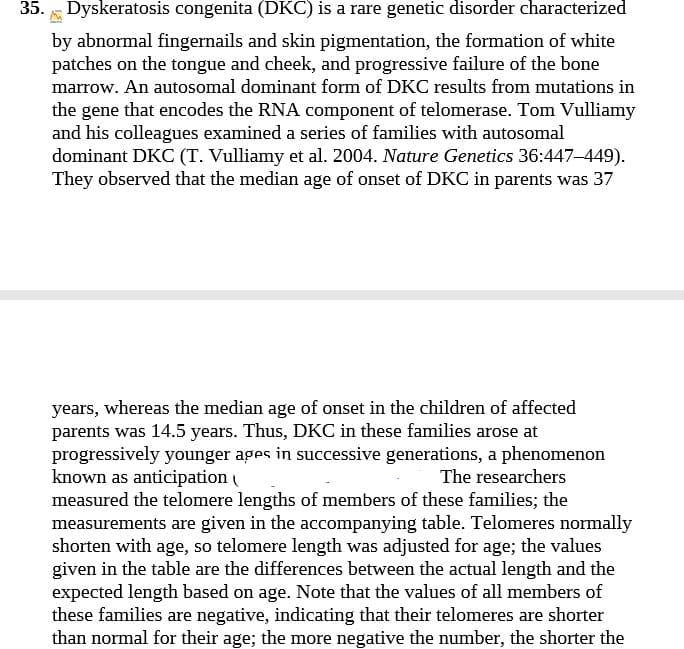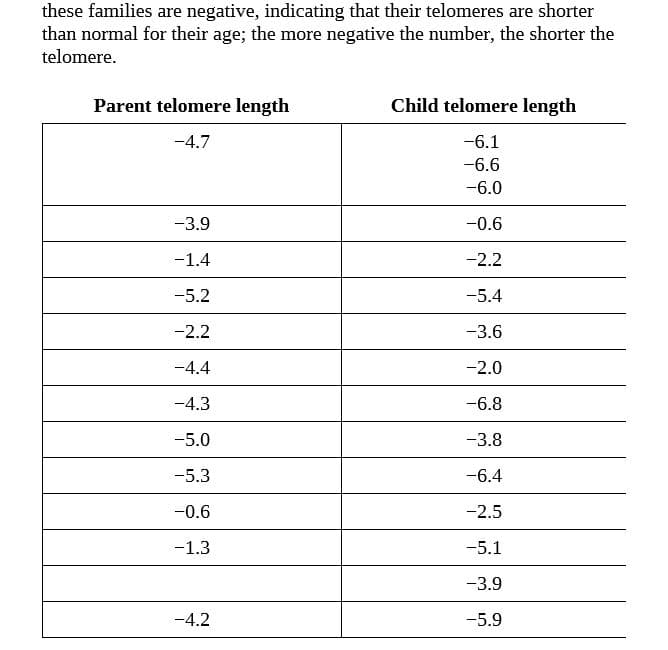35. Dyskeratosis congenita (DKC) is a rare genetic disorder characterized by abnormal fingernails and skin pigmentation, the formation of white patches on the tongue and cheek, and progressive failure of the bone marrow. An autosomal dominant form of DKC results from mutations in the gene that encodes the RNA component of telomerase. Tom Vulliamy and his colleagues examined a series of families with autosomal dominant DKC (T. Vulliamy et al. 2004. Nature Genetics 36:447-449). They observed that the median age of onset of DKC in parents was 37 years, whereas the median age of onset in the children of affected parents was 14.5 years. Thus, DKC in these families arose at progressively younger apes in successive generations, a phenomenon known as anticipation measured the telomere lengths of members of these families; the measurements are given in the accompanying table. Telomeres normally shorten with age, so telomere length was adjusted for age; the values given in the table are the differences between the actual length and the expected length based on age. Note that the values of all members of these families are negative, indicating that their telomeres are shorter than normal for their age; the more negative the number, the shorter the The researchers these families are negative, indicating that their telomeres are shorter than normal for their age; the more negative the number, the shorter the telomere. Parent telomere length Child telomere length -4.7 -6.1 -6.6 -6.0 -3.9 -0.6 -1.4 -2.2 -5.2 -5.4 -2.2 -3.6 -4.4 -2.0 -4.3 -6.8 -5.0 -3.8 -5.3 -6.4 -0.6 -2.5 -1.3 -5.1 -3.9 -4.2 -5.9
DNA and RNA
Deoxyribonucleic acid (DNA) is usually called the blueprint of life. Deoxyribose is a monosaccharide that has a key function in the synthesis of deoxyribonucleic acid. One less oxygen-containing hydroxyl group occurs in deoxyribose sugar. Nucleic acid, deoxyribonucleic acid, is one of the natural components. Deoxyribonucleic acid is a double-stranded molecule. Watson and Crick postulated the double-stranded model of the helix. A deoxyribonucleic acid is a molecular group that carries and transmits genetic information from parents to offspring. All eukaryotic and prokaryotic cells are involved.
DNA as the Genetic Material
DNA, or deoxyribonucleic acid, is a long polymeric nucleic acid molecule discovered in the late 1930s. It is a polymer; a long chain-like molecule made up of several monomers connected in a sequence. It possesses certain characteristics that qualify it as a genetic component. Certain organisms have different types of nucleic acids as their genetic material - DNA or RNA.
Genetics
The significant branch in science which involves the study of genes, gene variations, and the organism's heredity is known as genetics. It is also used to study the involvement of a gene or set of genes in the health of an individual and how it prevents several diseases in a human being. Thus, genetics also creates an understanding of various medical conditions.
DNA Replication
The mechanism by which deoxyribonucleic acid (DNA) is capable of producing an exact copy of its own is defined as DNA replication. The DNA molecules utilize a semiconservative method for replication.
How does the telomere length of the parents compare with the telomere length of the children? (Hint: Calculate the average telomere length of all parents and the average telomere length of all children.)


Trending now
This is a popular solution!
Step by step
Solved in 2 steps


